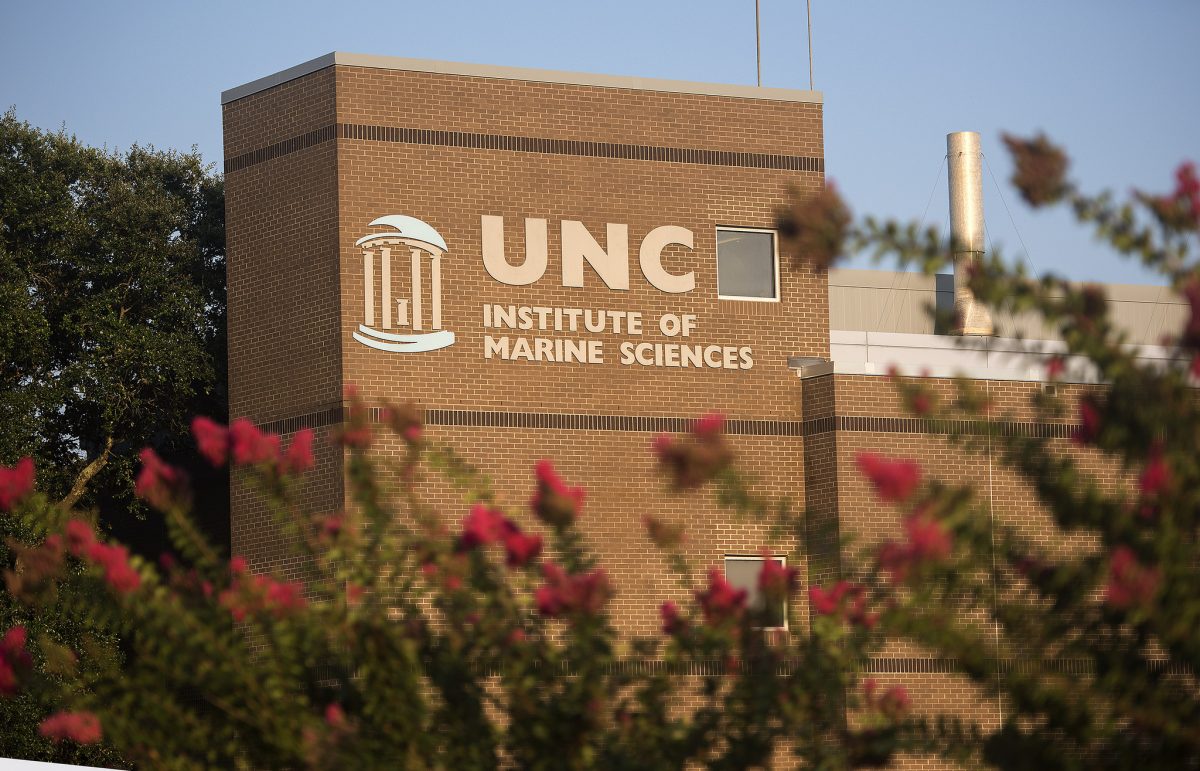
MOREHEAD CITY — Libby O’Malley drove into the parking lot of the University of North Carolina Chapel Hill’s Institute of Marine Sciences that day, cup of Dunkin Donuts coffee in hand, and looked up to find the answer to a question she’d been mulling for weeks.
There it was. The towering corner of one of the institute’s building that can be seen from traffic traveling in both directions on Arendell Street, Morehead City’s main drag and part of U.S. 70.
Supporter Spotlight
“I looked up and was like, that’s the biggest canvas,” said O’Malley, the institute’s development manager.

For more than a month she’d been thinking about how the campus, which next year will be celebrating its 75th anniversary in Morehead City, needs to beef up visibility on the thoroughfare where some 26,000 cars travel every day.
At least some road signs, she thought. Something to make the public, residents and tourists alike, aware that Carolina’s Institute of Marine Sciences, or IMS, is there.
It all came together, her old office view of a mural of two whales on the side of a multistory building in downtown San Diego, California, her time as a volunteer on Morehead City’s downtown revitalization committee and the city’s design committee when she overheard that at least 26,000 cars travel Arendell Street each day.
O’Malley’s aha moment came one summer day 2019 when she pulled into the parking for work and glanced up at the 40-foot-high brick wall where “UNC Institute of Marine Sciences” is spelled out in large lettering next to a depiction of the university’s iconic Old Well.
Supporter Spotlight
“A mural instantly puts you on the map,” she said. “It’s instant visibility.”
She took the idea to IMS Director Rick Luettich, an alumni distinguished professor who more than a decade ago spent the better part of two years advocating for the signage on the building that houses labs and classrooms.

“I do remember thinking this was a terrific idea,” Luettich said. “She didn’t have to convince me. For many years our building really had minimal signage on it and I don’t think many people knew we had a facility down here. The institute has always had in its mission to try to engage the public. The research we do here is all very applied and the goal has always been to solve problems that are related to coastal North Carolina. Communication with the public is certainly a part of things that we aspire to accomplish. We’re not an ivory tower kind of place here.”
He warned O’Malley to be prepared for what could be a challenging process to convince campus facilities officials to modify the appearance of the side of the building.
That turned out not to be the case.
O’Malley began making calls in late 2019 and early 2020 to pitch her idea to university officials — the building’s architect, a couple of folks on the university’s main campus some 175 miles away in Chapel Hill. So far, those she talked to had loved the concept.
“And then, COVID hit,” she said.
The COVID-19 pandemic, which shut down life as we knew it in March 2020, stalled, but didn’t stifle the process.
Kathryn Wagner, associate director of the university’s Arts Everywhere program, became a key ally.
Arts Everywhere started in 2016 with the mission to bring the arts to the center of the Carolina experience for students, staff and faculty.

“This is exactly the kind of project we love taking on,” Wagner said. “It is easy for your average student, let’s say, to forget UNC has all of these wonderful programs that don’t happen on main campus.”
Murals are on display at the university’s main campus.
With brick walls that span 11 feet wide and 40 feet high, IMS would lay claim to the university’s largest mural. It’s to be paid for through private funds.
IMS launched its call for artists’ proposals earlier this month. Proposals must be submitted by close of business Jan. 10.
“I can’t begin to conceive of what direction it would look like,” O’Malley said. “I expect that we’ll see a variety of interpretations of coastal North Carolina and marine science. This is the kind of thing that’s going to have wide appeal and not be controversial. The theme, marine science and the coastal environment, is a very aesthetically friendly theme and really in and of itself in our region looked at on a daily basis. It’s gorgeous here.”
Her goal, she said, is that the mural will become a you-have-arrived symbol for Morehead City.
“I think it certainly has the potential to become sort of a landmark,” Luettich said. “What I hope it serves as people go by and see that mural is, ‘Hmm, I wonder what that is?’ It’s a conversation starter for the community.”
Ideally, the mural will be finished no later than the first weekend of October, the weekend of the North Carolina Seafood Festival, O’Malley said.







